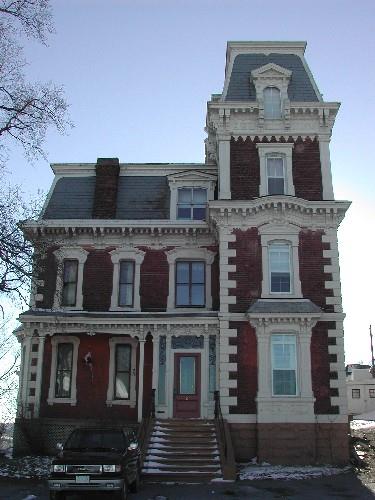GENERAL
Type / PurposePrivate Residence
2-4 Douglas Avenue, Saint John, New Brunswick
The Count DeBury Residence is a 19th-century mansion on Douglas Avenue in Saint John. It is made of brick and is two-and-a-half storeys tall, with a three-and-a-half storey tower on the side. It also has an overall luxurious appearance, with a spacious build and several decorative details.
The Count DeBury Residence is recognized as a Local Historic Place for its architecture and for being the residence of Count Robert DeBury. The Count DeBury Residence is noted for its high quality, which is representative of its residents' prestigious social standing. It was built in a luxurious Second Empire style, with an elaborate front facade and sixteen rooms at the time of construction.
The Count DeBury Residence is named after Count Robert Visart DeBury, who is also the namesake of Visart Street in Saint John. Count Robert Visart DeBury was a Belgian nobleman born in 1848 in Bury, Belgium. As a civil engineer and a graduate of the Wurttemberg School of Technology, Count DeBury worked for the Orleans Railway Company. He was also enlisted by the government of Wurtemberg to survey the Black Forest Railway. In 1869, Count DeBury married Lucy Simonds of Saint John and ordered a house in 1875 on land that was owned by Lucy's father, Henry G. Simonds. From then on, Count DeBury spent his time between Saint John and his original home in Bury.
Much of Count DeBury's family is notable as well. Two of his relatives played a major role in 16th-century Belgian politics. In the mid-1700s, Colonel Francis Visart de Soleilleval was granted the title of Count by the Empress Maria Theresa for his military service. Additionally, Count DeBury's great uncle, Field Marshall de Chasteler, defeated Napoleon's army in 1809 and later served as Governor of Venice. On a darker note, in 1851, when Robert was just three years old, Robert's father, Hippolyte Visart de Bocarmé, was infamously convicted and subsequently executed for fatally poisoning his brother-in-law in a bid to steal the man's inheritance.
Robert's children also played important roles in Saint John's history. His son, Lieutenant Colonel Count Henry R. Visart DeBury, is recognized for his outstanding military service. One of Robert's daughters (name unknown) was a highly talented painter. In 1897, one of her paintings was given to St. Pete's Church and was blessed by its clergymen.
Municipal Register of Local Historic Places (2008/08/18)
ARCHITECTURE
Date of Construction1875
- Luxurious two-and-a-half-storey Second Empire-style massing
- Three-and-a-half-storey side tower
- Mansard roof with wide brackets
- Pedimented dormers
- Dark red brick construction with contrasting white stone quoins
- Elevated entrance with wooden, glass-paneled door
- Various decorative elements including ornate bracketed cornices with fascia bands the façade and segmented, embellished arch openings
J. McDermott
W.P. Clarke
OWNERSHIP HISTORY
Notable Historic OccupantsCount Robert Visart DeBury (1848 - 1907):
A Belgian nobleman and civil engineer. After graduating from the Wurttemberg School of Technology, Count DeBury worked for the Orleans Railway Company. He was also enlisted by the government of Wurtemberg to survey the Black Forest Railway. Throughout his life he regularly travelled between this residence and his original home in Bury, Belgium. His title, Count, had been granted to his ancestor Colonel Louis-François Visart, lord of Bury and Bocarmé, by the Empress Maria-Theresa in 1753. Count DeBury passed away in a hospital on September 1st, 1907, a year after the death of his wife.
Countess Lucy DeBury / Lucy Simonds (???? - 1906):
Robert's wife, who he married in 1869. The land on which this residence stands originally belonged to her father, Henry G. Simonds.
Lieutenant Colonel Count Henry R. Visart DeBury (1872 - 1958):
Eldest son of Robert and Lucy. Henry had a long and successful career in the military that started in 1892. Originally joining the British Army as a second lieutenant in the Royal Artillery, he was promoted to lieutenant in 1895 and again to captain in 1900. He became During WWI, Henry was a Lieutenant-Colonel of a Canadian Field Artillery Brigade before becoming director of Canadian ordnance service in France, and though he retired from the military in 1936, he reenlisted during WWII to be a district ordnance officer, later being awarded a CBE.
Count Robert DeBury's painter daughter and other children
SOURCES AND DOCUMENTS
Links/Related Content Photos
Photograph by the City of Saint John, taken from the Canada's Historic Places website
Sources
Historic Places: Count DeBury Residence
My New Brunswick: Count DeBury Residence
Wikipedia: Henry de Bury
Gabrielle Byrne


